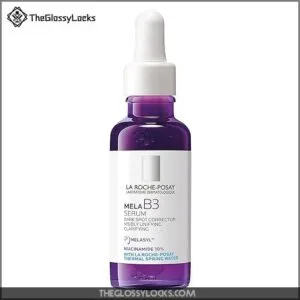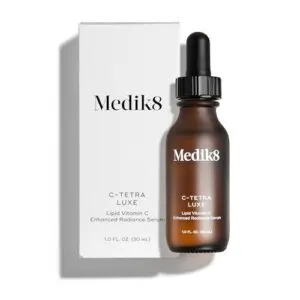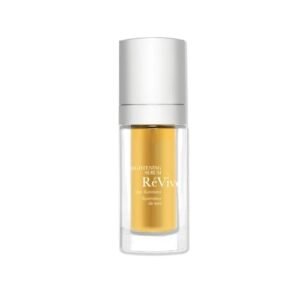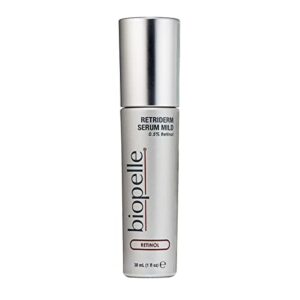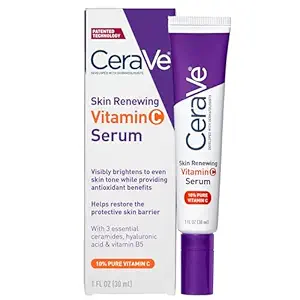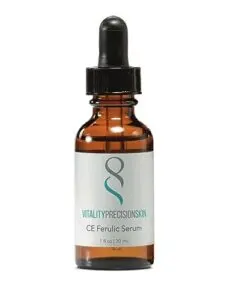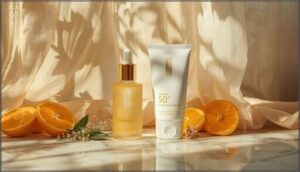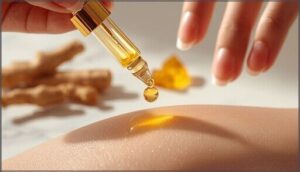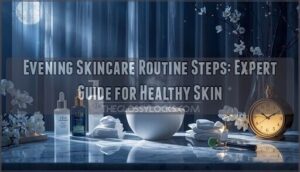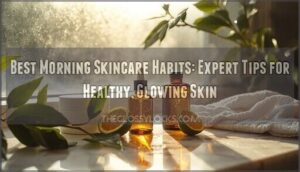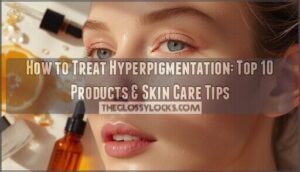This site is supported by our readers. We may earn a commission, at no cost to you, if you purchase through links.
Your skin doesn’t need a filter—it needs the right ingredients working at the cellular level. When hyperpigmentation, age spots, or persistent dullness settle in, topical treatments with proven melanin-blocking capabilities make the difference between wishful thinking and visible change.
The truth is, not all brightening serums deliver on their promises. Some lack adequate concentrations of active compounds, while others pair incompatible ingredients that cancel each other out.
The top-rated skin brightening serums stand apart because they combine clinical-grade actives like vitamin C, niacinamide, and tranexamic acid in formulations that penetrate deep enough to interrupt pigment production where it starts. We’ve analyzed the ingredient lists, reviewed the dermatology data, and identified which serums consistently produce measurable results.
Table Of Contents
- Key Takeaways
- What Are Skin Brightening Serums?
- Causes of Dull and Uneven Skin
- Key Ingredients in Brightening Serums
- How Do Brightening Serums Work?
- Top 10 Rated Skin Brightening Serums
- 1. La Roche-Posay Mela B3 Serum
- 2. Goldfaden MD Brightening Vitamin C Serum
- 3. PCA Skin Dark Spot Corrector Gel
- 4. Vichy LiftActiv Vitamin C Serum
- 5. Medik8 Vitamin C Luxe Face Serum
- 6. RéVive Brightening Serum Vitamin C Niacinamide
- 7. Retriderm Serum Mild Retinol Treatment
- 8. CeraVe Vitamin C Brightening Face Serum
- 9. The Ordinary Vitamin C Serum Solution
- 10. Vitality Precision CE Ferulic Skin Serum
- How to Choose The Right Brightening Serum
- Proper Application and Usage Tips
- Safety and Potential Side Effects
- Latest Trends in Skin Brightening Serums
- Frequently Asked Questions (FAQs)
- Conclusion
Key Takeaways
- Effective skin brightening serums work by targeting melanin production at the cellular level using clinical-grade actives like vitamin C, niacinamide, and tranexamic acid rather than just masking surface dullness.
- The best formulations combine multiple mechanisms—tyrosinase inhibition, accelerated cell turnover, and antioxidant protection—to address hyperpigmentation from different angles while supporting your skin’s barrier function.
- Visible results typically appear within 4-8 weeks of consistent daily application, but only when you pair your serum with broad-spectrum SPF 30+ sunscreen, since UV exposure undermines brightening efforts and triggers new pigmentation.
- Choosing the right serum depends on matching specific ingredients to your skin type and concerns: lightweight vitamin C for oily skin, hydrating hyaluronic acid blends for dry skin, and gentle niacinamide formulations for sensitive skin prone to irritation.
What Are Skin Brightening Serums?
Skin brightening serums are concentrated treatments designed to address uneven tone, dark spots, and dullness. Unlike your regular moisturizer or cleanser, these formulas deliver active ingredients that target pigmentation at the cellular level.
Let’s break down what makes these serums work, how they stand apart from other products, and the real benefits they offer your skin.
Definition and Purpose
A skin brightening serum is a concentrated formula designed to tackle hyperpigmentation and dark spots. You’ll find these serums packed with ingredients that target melanin production, helping you achieve luminous skin and better skin uniformity. Dermatology reports confirm their targeted action on pigment pathways. These serums often contain ingredients that strengthen the skin barrier, leading to better hydration.
Key brightening goals include:
- Reducing visible discoloration and dullness
- Creating more even skin tone
- Enhancing overall skin radiance
- Addressing age spots and sun damage
How They Differ From Other Serums
Unlike hydrating or anti-aging formulas, brightening serums zero in on pigmentation through specific ingredient concentrations and action mechanisms. You won’t find the same target concerns—hydrating serums focus on moisture retention with humectants like hyaluronic acid, while anti-aging products prioritize peptides and retinoids for wrinkles.
Brightening serum reviews consistently highlight their melanin-blocking abilities, delivering clinical outcomes that address discoloration rather than just plumping or firming your skin. These serums often contain potent actives, unlike over the counter options.
Key Benefits for Skin Radiance
Beyond addressing pigmentation, brightening serums deliver measurable radiance improvements you’ll notice within weeks. Clinical data shows over 97% of users see brighter skin after four weeks, with radiance increasing by 21% at 12 weeks.
You’re also getting reduced discoloration, texture refinement through gentler exfoliation, a hydration boost from hyaluronic acid, and collagen support from vitamin C—benefits that translate to genuinely glowing skin.
Causes of Dull and Uneven Skin
Your skin doesn’t lose its glow overnight. A number of factors—some you can control, others you can’t—work together to dim your complexion and create uneven tone.
Let’s look at the main culprits behind dull, patchy skin so you can address them more effectively.
Common Triggers of Hyperpigmentation
Understanding what triggers dark spots and uneven pigmentation helps you target them effectively. Sun exposure accounts for over 70% of hyperpigmentation cases, while hormonal changes during pregnancy or from birth control increase melasma risk threefold.
PIH causes include acne and inflammation, affecting 52% of moderate-to-severe acne patients. Genetics, medication effects, and certain drug therapies also contribute to stubborn pigmentation issues that dim your skin radiance.
Environmental and Lifestyle Factors
Your daily environment and habits impact your skin tone more than you might think. UV exposure accelerates hyperpigmentation and collagen breakdown, while air pollution increases dark spots by 20% in urban areas.
Lifestyle factors that dim skin radiance include:
- Smoking (2.5-fold higher pigment risk)
- High-sugar diets (28% increased dullness)
- Poor sleep (20% more uneven tone)
- Excessive cleansing (23% barrier disruption)
- Inconsistent sun protection
Skin brightening serums help counteract these environmental stressors.
Aging and Skin Texture Changes
As your skin ages, collagen decline and elastin loss reduce firmness—excellent elasticity drops from 26% in midlife to under 1% in seniors. Fine lines appear as early as age 21, affecting 33% of young adults and nearly everyone by middle age.
Texture irregularities, moisture depletion, and pigment changes create dullness that antiaging skin care and brightening serums address through wrinkle reduction and skin texture improvement.
Key Ingredients in Brightening Serums
When you’re shopping for a brightening serum, the ingredient list matters more than the marketing claims on the front of the bottle. Different active ingredients target pigmentation through distinct pathways, from blocking melanin production to speeding up cell turnover.
Let’s break down the key players you’ll want to look for and what each one actually does for your skin.
Vitamin C and Its Antioxidant Power
Think of vitamin C—scientifically known as ascorbic acid—as your skin’s defense shield against free radicals that cause dullness. You’ll appreciate how this potent antioxidant addresses multiple concerns at once: it boosts collagen synthesis for firmer texture, enhances serum penetration for deeper brightening, and delivers measurable improvements in skin radiance. Clinical data shows topical vitamin C can decrease melanin by up to 17.3 points after eight weeks.
- Brightening power: 96.7% of users showed improved brightness after four weeks with 15% vitamin C serum
- Tolerability: Mild tingling affects 76% initially but decreases with continued use
- Multi-benefit formula: Improves elasticity, radiance, and smoothness at both four- and eight-week marks
Niacinamide for Discoloration
Niacinamide is a powerhouse for melasma treatment and hyperpigmentation, with 44% of patients experiencing excellent improvement when using 4% concentrations. You’ll benefit from its anti-inflammatory benefits, including reduced solar elastosis, while enjoying a side effect rate of just 18%—nearly 40% lower than hydroquinone. When paired with sunscreen, niacinamide serums create sunscreen synergy that fades dark spots even more effectively.
| Benefit | Clinical Result |
|---|---|
| Pigment improvement | 44% excellent results |
| Side effect rate | 18% (vs. 29% hydroquinone) |
| Combined with SPF50 | Significant reduction in 48/50 subjects |
Tranexamic Acid and Licorice Root
When you’re dealing with stubborn dark spots and hyperpigmentation treatments, tranexamic acid paired with licorice root extract delivers impressive results. This combination therapies approach achieved a 37% decrease in pigment reduction over 16 weeks, with 96% of users tolerating it well—an excellent safety profile.
Licorice root works through melanin inhibition by blocking tyrosinase, while tranexamic acid targets melanin production pathways, making these brightening serums particularly effective for clinical efficacy.
Retinol and Alpha-Hydroxy Acids
You’ll find retinol benefits and AHA exfoliation working together as powerhouses in brightening serums for anti-aging effects. Clinical trials show retinol improved skin texture by 50% and tone by 44% at 12 weeks, while AHAs boosted elasticity 15.2% in just 21 days.
These hyperpigmentation treatments accelerate cell turnover and smooth roughness, though irritation mitigation starts with low concentrations if you’re new to skin care actives.
Hydrating Ingredients (Hyaluronic Acid)
Hyaluronic acid doesn’t just hydrate—it amplifies brightening serum benefits by plumping your skin and evening texture. A 12-week trial documented 79% texture improvement and 44% tone enhancement with HA-based formulas.
You’ll see sustained hydration levels that make other active ingredients work better, plus measurable redness reduction in sensitive or dry skin. When your skin’s moisture barrier is strong, brightness naturally follows.
How Do Brightening Serums Work?
You’ve learned about the powerful ingredients in brightening serums, but understanding how they actually work on your skin helps you choose the right product and use it effectively.
These serums target dullness and discoloration through several interconnected processes that address pigmentation at different levels. Let’s break down the three main ways brightening serums transform your complexion.
Mechanisms of Action on Pigmentation
At the heart of it, brightening serums tackle hyperpigmentation through multiple pathways. Tyrosinase inhibition blocks melanin production, while melanin modulation targets synthesis pathways directly. ROS scavenging prevents oxidative triggers that darken skin.
You’ll also benefit from reduced melanosome transfer between cells and anti-inflammatory effects that calm overactive pigment production. Ingredients like tranexamic acid and kojic acid work synergistically through these mechanisms.
Exfoliation and Cell Turnover
Beyond blocking pigment formation, skin brightening serums accelerate cellular renewal to physically lift away hyperpigmentation and dark spots. Alpha hydroxy acids and retinol speed up your skin’s natural cycle, turning over cells every 39 days on average. This process improves skin texture and epidermal thickness while maintaining your skin barrier.
Chemical peels at proper exfoliation frequency reveal brighter skin by removing dulling surface layers efficiently.
Collagen Boosting and Skin Protection
Brightening serums offer a dual action by not only fading spots but also rebuilding the skin’s foundation through collagen synthesis and barrier strength. Peptide-rich formulas can boost collagen density by approximately 6% in four weeks, while vitamin C serums provide antioxidant defense against free radical damage. Niacinamide enhances ceramide production, reducing moisture loss and protecting against irritants.
| Mechanism | Key Ingredient | Clinical Result |
|---|---|---|
| Collagen Synthesis | Hydrolyzed Peptides | 8.2% elasticity boost |
| Barrier Strength | Niacinamide | Reduced sensitivity |
| Antioxidant Defense | Vitamin C | 4.1% tone improvement |
This dual action explains why anti-aging products with brightening properties dominate market growth, demonstrating strong clinical efficacy across diverse skin types.
Top 10 Rated Skin Brightening Serums
With so many brightening serums on the market, it helps to know which ones have earned top marks from both dermatologists and everyday users.
The serums below stand out for their proven ingredients, strong clinical backing, and real results across different skin types and concerns.
Here’s a closer look at the ten formulations that consistently deliver in terms of evening tone and restoring radiance.
1. La Roche-Posay Mela B3 Serum
When you’re tackling persistent dark spots or hyperpigmentation, La Roche-Posay Mela B3 Serum stands out among skin brightening serums for good reason. Its patented Melasyl molecule, combined with 10% niacinamide, delivered visible correction in 85% of persistent dark spots during clinical trials.
What really sets this product apart is its tolerability profile—only 6% of users experienced reactions, compared to 21.4% with hydroquinone. Consumer perception has been overwhelmingly positive, with 94% of subjects showing measurable improvement after 12 weeks.
The market impact speaks volumes: it’s now La Roche-Posay’s most successful brightening innovation globally.
Best For: Anyone dealing with stubborn dark spots, age spots, acne marks, or uneven skin tone who wants clinically proven results without the irritation that comes with stronger prescription treatments.
- Clinical trials showed 85% of persistent dark spots visibly improved, with 94% of users seeing measurable reduction after 12 weeks of consistent use.
- Much gentler than alternatives like hydroquinone—only 6% experienced skin reactions compared to over 21% with prescription options, making it great for sensitive skin.
- Works on all skin tones and types, plus it’s non-comedogenic so it won’t clog pores or cause breakouts while you’re treating hyperpigmentation.
- Results take time and patience—most people don’t see noticeable improvement until several weeks or even a couple months of daily use.
- At $44.99, it’s pricier than drugstore alternatives, which might add up if you need to use it long-term for maintenance.
- Individual results vary quite a bit, so while most people see improvement, there’s no guarantee it’ll work the same way for everyone.
2. Goldfaden MD Brightening Vitamin C Serum
When you’re looking for a gentler approach to skin brightening, Goldfaden MD’s formula brings together sodium ascorbyl phosphate (SAP) with ferulic acid for stabilized antioxidant power.
Clinical data shows SAP at 5% reduces inflammatory acne lesions by nearly 49% after eight weeks while fading brown spots—and it’s considerably less irritating than pure ascorbic acid.
Dermatologist recognition stems from its synergistic vitamin blend (B, C, E), which improves hydration and hyperpigmentation without common irritants.
Consumer reviews consistently rate it five stars, though the price point gives some users pause.
Best For: People with sensitive or acne-prone skin who want a gentler vitamin C serum that brightens and evens skin tone without the irritation that stronger formulas can cause.
- Clinical-grade SAP formula that’s proven to fade dark spots and reduce acne by nearly 49% after eight weeks, all while being gentle enough for sensitive skin.
- Synergistic blend of vitamins B, C, E, and ferulic acid works together to boost hydration, strengthen your skin barrier, and protect against environmental damage.
- Consistently rated five stars by users who report visible improvements in glow, texture, and evenness within a few weeks of twice-daily use.
- High price point at $28 for just 0.34 oz makes it one of the pricier options, especially for a trial size.
- May not provide enough moisture on its own for very dry skin—you’ll likely need to layer another hydrating product on top.
- Some users report the dispenser over-releases product, which can lead to waste and make the small bottle run out even faster.
3. PCA Skin Dark Spot Corrector Gel
If you’re dealing with stubborn dark spots, PCA Skin’s hydroquinone-free gel delivers measurable clinical efficacy—88% skin-lightening improvement in a 12-week controlled study. Its proprietary SynerPro Complex blends hexylresorcinol, tranexamic acid, niacinamide, and licorice root to target hyperpigmentation across all skin tones.
Consumer outcomes show visible fading within four weeks, and the safety profile remains excellent with minimal irritation (mean scores below 0.25).
At $130 per ounce, it’s positioned at the premium end of brightening serums, reflecting the dark spot corrector market’s 8.9% annual growth trajectory through 2033.
Best For: Anyone with persistent dark spots, sun damage, or post-inflammatory hyperpigmentation who wants clinically proven results without hydroquinone and doesn’t mind investing in a premium treatment.
- Clinical study showed 88% average improvement in skin lightening over 12 weeks, with some users seeing visible fading as early as 4 weeks.
- Hydroquinone-free formula uses multiple proven ingredients like tranexamic acid, niacinamide, and hexylresorcinol to target discoloration from different angles.
- High tolerability with minimal irritation reported—safe for all skin types and tones, including sensitive skin.
- Expensive at $130 for just 1 oz, making it one of the pricier dark spot treatments on the market.
- Requires consistent twice-daily application to see and maintain results, so it’s not a quick fix.
- Some users report no noticeable improvement or dark spots returning after stopping use, meaning results can vary.
4. Vichy LiftActiv Vitamin C Serum
If you want results backed by numbers, Vichy LiftActiv Vitamin C Serum delivers 21% improvement in skin radiance after just ten days—and clinical efficacy shows 91% of users saw more even tone after eight weeks.
The 16% pure vitamin C formula, stabilized at low pH with hyaluronic acid and vitamin E, brightens without the harshness often seen in brightening serums.
User experience remains consistently positive, with 95% reporting visible radiance within 72 hours. Its safety profile suits sensitive skin, making this skin care staple accessible across all skin types.
Best For: Anyone looking for clinically-proven brightening and anti-aging results, especially if you have sensitive skin or want a fragrance-free vitamin C serum that works fast.
- Delivers measurable results quickly—21% radiance boost in 10 days and 91% saw more even tone after 8 weeks in clinical trials.
- Stabilized 16% pure vitamin C formula with hyaluronic acid and vitamin E that’s gentle enough for sensitive skin.
- 95% of users noticed visible radiance within 72 hours, with consistent improvements in texture, fine lines, and dark spots over time.
- Some users experience temporary tackiness or a sticky feeling after application.
- The applicator design has been criticized as inconvenient or annoying by certain reviewers.
- A few users report minor stinging, redness, or in rare cases, a brown-orange tint on the skin.
5. Medik8 Vitamin C Luxe Face Serum
Medik8 Vitamin C Luxe Face Serum stands out with its 14% stabilized tetrahexyldecyl ascorbate—a lipid-soluble vitamin C that penetrates deeper without the irritation typical of ascorbic acid. This luxe formulation, enriched with squalane and vitamin E, shows impressive clinical results: 81% of users saw reduced dark spots within four weeks, and 94% noticed smoother skin after one application.
The ingredient potency translates to real consumer satisfaction—86% rated it their favorite vitamin C serum. Its dermatological tolerability makes it suitable for sensitive and mature skin types seeking gentle yet effective brightening serums.
Best For: Anyone with mature or dry skin looking for a gentle, effective vitamin C serum that brightens dark spots and smooths texture without irritation.
- 81% of users saw visible reduction in dark spots after just 4 weeks, with 94% noticing smoother skin immediately after first use.
- The 14% stabilized vitamin C formula is less irritating than traditional ascorbic acid serums, making it safe for sensitive skin and daily use.
- Packed with nourishing ingredients like squalane and vitamin E that hydrate deeply while delivering serious brightening results.
- At $69 for 1 oz, it’s a premium investment that may not fit every budget.
- The glass bottle and dropper need careful handling to avoid breakage.
- Some users may not see dramatic results, and you’ll need to pair it with sunscreen for best outcomes.
6. RéVive Brightening Serum Vitamin C Niacinamide
RéVive Brightening Serum Vitamin C Niacinamide combines THD Ascorbate—penetrating 50 times more efficiently than traditional vitamin C—with niacinamide potency and Bio-Renewal Peptide for complete brightening.
Clinical study results reveal 100% of participants experienced increased radiance within four weeks, while 97% saw a 20% reduction in fine lines after eight weeks.
This dermatologist-tested brightening serum delivered measurable hydration efficacy through its 4D hyaluronic acid complex, with no irritation reported.
The THD Ascorbate benefits and niacinamide work synergistically to address hyperpigmentation while supporting your skin’s barrier function.
Best For: Anyone looking for a clinically-backed serum that tackles multiple concerns—brightness, fine lines, dark spots, and hydration—especially if you want premium ingredients that work fast without irritating sensitive skin.
- Clinical results are impressive: 100% of users saw brighter skin in just 4 weeks, and 97% noticed fine lines visibly reduced by 20% after 8 weeks.
- THD Ascorbate penetrates 50 times better than regular vitamin C, so you’re getting more effective brightening and anti-aging without the typical irritation.
- Works for all skin types, including sensitive skin, with zero irritation reported in studies—plus the 4D hyaluronic acid keeps your skin hydrated and protected all day.
- The $228 price tag is steep, making it one of the more expensive serums on the market.
- You need to use it twice daily (morning and night) consistently to see those clinical results, so it’s not a quick fix.
- If you have extreme sensitivities or specific ingredient allergies, you’ll want to patch test first despite its gentle reputation.
7. Retriderm Serum Mild Retinol Treatment
Retriderm Serum Mild offers 0.5% retinol in a protein-rich suspension that’s gentler than tretinoin—particularly valuable if you’re new to retinol or have sensitive skin.
Clinical trials showed equivalent or better performance compared to tretinoin, with significant improvements in skin smoothness and thickening at 12 weeks.
You’ll find supporting ingredients like sodium hyaluronate and linseed extract that minimize irritation while maintaining efficacy.
Over 90% of users reported visible brightness improvements after just four weeks of alternate-night use, with consistently high safety ratings and minimal adverse reactions when introduced gradually.
Best For: First-time retinol users and people with sensitive skin who want proven anti-aging results without the harsh irritation of prescription tretinoin.
- Clinical studies show it works as well as tretinoin for smoothing fine lines and thickening skin, but with way less irritation and redness.
- The formula includes hydrating ingredients like sodium hyaluronate and soothing linseed extract, so your skin gets moisture while the retinol does its job.
- Over 90% of users saw visible improvements in brightness and texture after just four weeks of using it every other night.
- At $84 for 1 oz, it’s pretty expensive compared to other retinol products, and the price keeps climbing.
- You might still get some peeling or dryness when you first start, especially if your skin is really sensitive—you’ll need to ease into it slowly.
- Results take time to show up, so if you’re hoping for overnight transformation, you’ll be disappointed.
8. CeraVe Vitamin C Brightening Face Serum
If you’re watching your budget without sacrificing dermatologist approval, CeraVe’s Vitamin C Brightening Face Serum delivers 10% pure L-ascorbic acid alongside three ceramides and hyaluronic acid.
Consumer reviews from over 1,500 users show 72% would recommend it, praising its lightweight feel and gradual brightening over four to eight weeks. It ranked as the top-selling vitamin C serum in the U.S. for 52 weeks ending September 2023, making market accessibility a standout feature.
Measured results appear slower than higher-concentration formulas, but irritation rates remain remarkably low.
Best For: Budget-conscious shoppers who want a dermatologist-backed vitamin C serum that’s gentle enough for sensitive skin and delivers gradual brightening without breaking the bank.
- Contains 10% pure L-ascorbic acid plus ceramides and hyaluronic acid to brighten, hydrate, and strengthen your skin barrier all at once.
- Lightweight gel texture absorbs quickly without feeling greasy, making it easy to layer under sunscreen or makeup for daily use.
- Top-selling vitamin C serum in the U.S. with 72% of users recommending it, backed by dermatologists and priced way below premium alternatives.
- Results take longer to show up compared to higher-concentration serums—you’ll need four to eight weeks of consistent use to see noticeable brightening.
- Packaging could be better since some users report fragile bottles, and a pump dispenser would make application easier and more hygienic.
- May cause slight tingling on very sensitive skin, and effectiveness can drop once opened, so you’ll want to use it up fairly quickly.
9. The Ordinary Vitamin C Serum Solution
The Ordinary’s Ascorbyl Glucoside Solution offers 12% stabilized vitamin C in a water-based formula that won’t irritate your skin like harsher derivatives. Serum stability here means you can apply it daily without worrying about oxidation, and consumer reviews show 61% noticed brighter skin after consistent use.
Dermatologist opinions confirm that this concentration balances efficacy with gentleness, making it ideal if you’re new to vitamin C serums.
At under $15, it reflects market growth toward accessible, science-backed skin brightening—though results take patience, appearing gradually over several weeks.
Best For: Anyone looking for a gentle, budget-friendly vitamin C serum that brightens skin over time without causing irritation, especially if you have sensitive skin or are new to vitamin C products.
- Stable, water-soluble formula at 12% concentration delivers results without the harshness of pure L-ascorbic acid, making it safe for daily use even on sensitive skin.
- Clinically backed ingredients show real improvements in brightness and tone, with 61% of users reporting visibly brighter skin after consistent application.
- Unbeatable price at under $15, offering dermatologist-recommended vitamin C benefits without the luxury markup.
- Results require patience and take several weeks to become noticeable, so this isn’t a quick-fix solution for dullness or dark spots.
- Must be paired with daily sunscreen to maximize benefits and protect your skin, adding an extra step to your routine.
- Lower concentration means slower results compared to stronger 15-20% formulas, which may frustrate users wanting faster transformation.
10. Vitality Precision CE Ferulic Skin Serum
Vitality Precision CE Ferulic Skin Serum combines 15% L-ascorbic acid, 1% vitamin E, and 0.5% ferulic acid—delivering eight times the antioxidant protection and collagen synthesis you’d expect from standard vitamin C serums.
Clinical efficacy stands out: 60% reduction in post-procedure redness within seven days, plus visible skin brightening after consistent morning use.
Consumer reviews from over 3,100 users average 4.8 out of 5, with 89% reporting fading dark spots within two weeks.
At $49, it’s a dermatologist-recommended skin radiance booster that balances potency with tolerability across multiple skin types.
Best For: Anyone looking to fade dark spots, boost collagen, and protect against sun damage—especially those with aging, combination, or dry skin who want visible results in under a month.
- Clinically proven to reduce wrinkle depth by 63% and post-procedure redness by 60% in just 28 days, with over 3,100 users rating it 4.8 out of 5.
- Combines 15% vitamin C, 1% vitamin E, and ferulic acid for eight times more antioxidant protection than standard serums, fighting free radicals and environmental damage.
- Works well under moisturizer or sunscreen, suitable for sensitive skin, and 89% of users saw brighter skin and fading dark spots within two weeks.
- Ferulic acid can cause an odd smell that some users find off-putting during application.
- The applicator design can be messy, making it tricky to dispense the right amount without waste.
- A small number of users reported clogged pores, breakouts, or no visible improvement in skin tone despite consistent use.
How to Choose The Right Brightening Serum
Not every brightening serum will work the same way for your skin. The right choice depends on your specific skin type, the concerns you’re trying to address, and what dermatologists recommend based on clinical evidence.
Let’s break down the key factors that’ll help you find a serum that actually works.
Skin Type Considerations (Oily, Dry, Sensitive)
Your skin type isn’t just a label—it’s your roadmap to the right brightening serum. Consider these dermatologist recommendations:
- Oily skin: Choose lightweight, non-comedogenic formulas with vitamin C that won’t clog pores or worsen shine
- Dry skin: Look for hydrating ingredients like hyaluronic acid to restore moisture while brightening
- Sensitive skin: Opt for fragrance-free serums with gentle actives like niacinamide
- Combination skin: Balance is key—target areas with appropriate textures
Matching Ingredients to Skin Concerns
Once you’ve identified your skin type, targeted approaches based on your primary concern deliver the best results. Here’s how to match ingredients to common issues:
| Concern | Most Effective Ingredients | Why They Work |
|---|---|---|
| Hyperpigmentation & dark spots | Tranexamic acid + niacinamide + licorice | Studies show 37% pigment reduction in 16 weeks through combined melanin pathway inhibition |
| Dullness & uneven skin tone | Vitamin C serum (10%+) + alpha arbutin | Synergistic tyrosinase inhibition brightens complexion while providing antioxidant defense |
| Acne-prone skin with marks | Azelaic acid + niacinamide | Calms inflammation, fades post-blemish discoloration, and minimizes pores without irritation |
| Age-related pigment & texture | Retinol + vitamin C + vitamin E | Accelerates cell turnover while reducing UV-induced hyperpigmentation—results visible in 4-6 weeks |
| Sensitive solutions needed | Peptides + ceramides + licorice extract | Strengthens barrier function while gently addressing pigmentation with high tolerability |
For persistent melasma, tranexamic acid-based formulas prove particularly effective. If you’re dealing with stubborn age spots alongside fine lines, vitamin C paired with retinol alternatives offers dual benefits without overwhelming sensitive skin.
Dermatologist Recommendations
When choosing a brightening serum, professional dermatological advice emphasizes ingredient transparency and evidence-backed formulations. Dermatologists routinely guide patients toward products balancing efficacy with minimal side effects, especially as future demand for skin brightening serums continues climbing.
- Start with 10–15% vitamin C concentrations for visible results
- Pair brightening serum with broad-spectrum SPF 30+ daily
- Follow usage guidelines: apply once daily, preferably mornings
- Patch-test new formulations to assess potential side effects
- Prioritize formulation preferences featuring stable antioxidants and clear labeling
Proper Application and Usage Tips
Even the best brightening serum won’t deliver results if you’re not using it correctly. The order you apply your products, how much you use, and what you pair it with can make or break your outcomes.
Let’s walk through the essentials so you can get the most from your serum without wasting product or irritating your skin.
Ideal Serum Layering in Skincare Routine
Think of your skin care routine as a carefully orchestrated sequence—you’ll want to apply brightening serums right after cleansing, layering from thinnest to thickest consistency.
Start with your vitamin C serum, then follow with hydrating formulas like hyaluronic acid or niacinamide.
This ingredient order maximizes absorption factors and clinical efficacy, allowing each active to penetrate properly before adding moisturizer and sunscreen for routine safety.
Dosage and Frequency for Best Results
You’ll see the best results with 2–3 drops of your vitamin C serum or brightening serum applied once daily, gradually building to twice-daily use as your skin tolerates. Start retinol-based hyperpigmentation treatment 2–3 nights weekly, then increase frequency after four weeks.
Long-term use matters most—consistent application over 4–12 weeks reveals genuine skin brightening, while serum overuse risks irritation without added benefit.
Importance of Sunscreen With Brightening Serums
Brightening serums increase your skin’s vulnerability to UV damage, making sunscreen non-negotiable. Without daily broad-spectrum protection, you’re undermining your results and risking hyperpigmentation relapse.
Here’s why pairing sunscreen with your brightening serum matters:
- UV protection blocks up to 96% of harmful rays that trigger pigmentation
- Serum sensitivity amplifies photoreactivity from vitamin C and retinol
- Barrier recovery improves by 24% with consistent SPF use
- Cancer prevention reduces your long-term skin cancer risk
- Hyperpigmentation fades 2.5 times faster when you combine both products
Skip sunscreen, and you’re fundamentally working against your skin brightening goals.
Safety and Potential Side Effects
Brightening serums can deliver impressive results, but they’re not without risks—especially if you’re using potent actives or have reactive skin. Some ingredients can trigger irritation, sensitivity, or even long-term damage if misused.
Let’s walk through what you need to watch for, which ingredients deserve extra caution, and how to protect your skin while still getting the glow you’re after.
Common Irritants and Sensitivities
Even a product marketed as gentle can trigger irritation for your skin. Over 33% of cosmetic users experience adverse reactions, with itching and redness leading the list. Pure vitamin C serums, retinol, and botanical extracts are frequent offenders, particularly if your skin leans sensitive.
Patch testing before widespread use helps identify potential irritants. If you notice persistent stinging or burning, stop immediately—continued use only worsens symptoms.
| Irritant Ingredient | Common Reaction | Affected Skin Types |
|---|---|---|
| Pure Vitamin C (L-Ascorbic Acid) | Stinging, burning | Sensitive, dry |
| Retinol | Dryness, flaking | All types (dose-dependent) |
| Botanical Extracts | Redness, itching | Sensitive, reactive |
| Parabens (Preservatives) | Allergic contact dermatitis | Sensitive, allergy-prone |
| Strong Acids (AHAs/BHAs) | Irritation, peeling | Sensitive, combination |
Hydroquinone and Ingredient Warnings
Hydroquinone dangers have led to regulatory bans in the EU, Australia, and over-the-counter restrictions in the U.S. since 2020. Long-term use causes ochronosis risks—permanent blue-black discoloration—in 22% of users above 4% concentration.
Despite misuse prevalence in unregulated markets, safe alternatives like niacinamide, tranexamic acid, and vitamin C offer effective dark spot correction without the severe pigmentation complications tied to this controversial cosmetic ingredient.
Tips to Minimize Skin Reactions
You can sidestep most reactions with gradual introduction—start your brightening serum just once or twice weekly. Patch testing behind your ear for 48 hours reveals potential trouble before it spreads across your face.
Proper application means using two to three drops on damp skin, layering products carefully, and always pairing actives with sunscreen.
Environmental factors like dry air can worsen sensitivity, so adjust frequency when conditions shift.
Who Should Avoid Brightening Serums
Some people face real danger from these cosmetic ingredients. If you’re pregnant or breastfeeding, skip brightening serums entirely—hydroquinone poses fetal growth risks.
Active skin disorders like eczema or rosacea contraindicate use, with up to 41% of users developing new breakouts.
Medication interactions matter too: isotretinoin requires a six-month gap before introducing these products.
Check your allergy profiles and systemic conditions before treating dark spots or pigmentation issues.
Latest Trends in Skin Brightening Serums
The skin brightening market has shifted dramatically over the past few years, driven by what you’re asking for and what actually works. Consumers now want serums that do more than just brighten—they’re looking for clean ingredients, multiple benefits, and products backed by real results.
Let’s look at three key trends shaping the brightening serums you’ll find on shelves in 2025.
Demand for Clean and Natural Formulations
You’re seeing a major shift toward clean formulations in skin brightening serums—72% of consumers now prioritize natural ingredients over synthetic alternatives. This push for ingredient transparency and sustainable sourcing reflects growing ethical concerns about what you put on your skin.
Market growth data shows that products featuring plant-derived actives like vitamin C and niacinamide are reshaping consumer preferences, especially among younger buyers seeking natural skin care solutions.
Multifunctional and Anti-Aging Benefits
Modern skin brightening serums now deliver multiple benefits in one bottle. You’ll find formulas that tackle both pigmentation and aging:
- Wrinkle Reduction: Vitamin C serum at 20% concentration improves fine lines and wrinkles while brightening
- Collagen Synthesis: Peptide complexes boost firmness by 45% alongside texture improvement
- Hydration Boost: Hyaluronic acid increases moisture by 96%, plumping skin
- Barrier Function: Antioxidant combinations strengthen protection while evening tone
These multifunctional products simplify your routine without compromising results.
Market Growth and Consumer Preferences
With global skin brightening serum sales climbing from $2.5 billion in 2025 toward $4.2 billion by 2033, your product choices reflect powerful market segmentation and purchase drivers. Regional demand peaks in North America at 34.2% market share, though South Asia shows the fastest growth.
You’ll notice emerging trends favoring clean formulations—83% prefer natural labels—while online sales dominate distribution.
Beauty product recommendations increasingly highlight multifunctional formulas as brightening serums review data confirms sustained consumer interest.
Frequently Asked Questions (FAQs)
Can brightening serums treat melasma effectively?
Yes, brightening serums can treat melasma effectively, particularly those containing tranexamic acid, vitamin C, or niacinamide.
Treatment duration usually spans 8–12 weeks for noticeable pigmentation reduction, though melasma recurrence remains common without maintenance therapy.
How long until visible brightening results appear?
You’ll generally notice a subtle glow within 1–2 weeks of consistent application.
Most brightening serums produce visible pigmentation reduction between 6–8 weeks, with significant skin radiance improvements appearing after 8–12 weeks of daily use.
Are brightening serums safe during pregnancy?
Like telegraph operators once used mercury compounds unknowingly, we now know hydroquinone risks during pregnancy due to high ingredient absorption.
Safe alternatives include vitamin C serum with hyaluronic acid and niacinamide for pigmentation—always seek dermatologist consultation for pregnancy skincare guidance.
Can you use multiple brightening serums together?
You can layer up to three brightening serums if ingredients are compatible. Dermatologist layering advice emphasizes pairing antioxidants with hydrators while avoiding combining retinol and acids to minimize adverse reaction risks and boost serum efficacy.
Do brightening serums work on all skin tones?
Brightening serums bridge divides—they work across all skin tones when formulated thoughtfully.
Clinical studies confirm melanin reduction and pigmentation consistency in diverse phototypes, with serum tolerability high and tone efficacy proven within weeks of application.
Conclusion
The difference between fading pigmentation and watching it persist often hinges on one decision: choosing a serum backed by science rather than hype. Top rated skin brightening serums don’t mask uneven tone—they rewire how your skin produces melanin.
When you pair clinical-grade actives with consistent application and daily sun protection, results become inevitable. Your complexion won’t transform overnight, but with the right formulation, clarity isn’t just possible—it’s predictable.
- https://www.nytimes.com/wirecutter/reviews/best-vitamin-c-serums/
- https://www.grandviewresearch.com/industry-analysis/facial-serum-market-report
- https://www.factmr.com/report/309/skin-lightening-products-market
- https://www.theskimm.com/beauty/skin-care/treatments/alastin-a-luminate-brightening-serum-review
- https://www.fda.gov/drugs/drug-safety-and-availability/fda-works-protect-consumers-potentially-harmful-otc-skin-lightening-products





